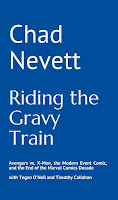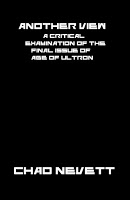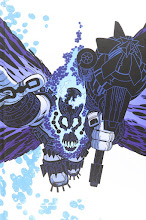 After ordering it a few weeks back, I got Avengers Assemble: An Oral History of Earth's Mightiest Heroes by Brian Michael Bendis this week. It's a book collecting the "Oral History of the Avengers" back-up feature that ran through Avengers #1-9, 11-12, and New Avengers #1-11 (the book says it also collects material from Avengers #10, but the back-up feature didn't run in that issue). For whatever reason, the feature stopped after Avengers #12 after covering "The Korvac Saga," and Bendis used the idea of an oral history as a narrative framing device for both titles' Fear Itself tie-in issues. Judging by reactions at the time, the feature could have been cancelled because, well, no one seemed to like it (except me and a few others). Or maybe it was most cost effective to lose those pages and keep the price the same. I don't know. But, surprisingly, Marvel has released a collection of that material, including some new material.
After ordering it a few weeks back, I got Avengers Assemble: An Oral History of Earth's Mightiest Heroes by Brian Michael Bendis this week. It's a book collecting the "Oral History of the Avengers" back-up feature that ran through Avengers #1-9, 11-12, and New Avengers #1-11 (the book says it also collects material from Avengers #10, but the back-up feature didn't run in that issue). For whatever reason, the feature stopped after Avengers #12 after covering "The Korvac Saga," and Bendis used the idea of an oral history as a narrative framing device for both titles' Fear Itself tie-in issues. Judging by reactions at the time, the feature could have been cancelled because, well, no one seemed to like it (except me and a few others). Or maybe it was most cost effective to lose those pages and keep the price the same. I don't know. But, surprisingly, Marvel has released a collection of that material, including some new material.The new material isn't much: an additional chapter covering the Scarlet Witch's possession by a demon and a very brief epilogue. All told, the "Oral History" doesn't even reach The Avengers #200 before stopping, which makes the concept a little half-baked if we're to read this as a book published in the Marvel Universe. I understand the project ended at this point (I'm somewhat surprised given Bendis's habit of writing ahead that he wasn't up to The Crossing already), but, then, why publish the collection?
The carryover to book format isn't a smooth one either. While it's common practice to simply collect issues of comics without making changes of any kind, this isn't a comic. This is a prose book and the 'copy and paste' method left many parts of this book reading awkward. One big carryover is the reintroduction of titles/roles of characters in parantheses whenever a new chapter begins; or, in the case of the first chapter, which was split across Avengers and New Avengers #1, at the point where that chapter was split. You go from simply having "Dr. Henry Pym" to "Dr. Henry Pym, Ph.D. (Ant-Man, Giant-Man, Avengers founder)" partway though a chapter. This isn't a big problem, but even the continued reuse of titles every time a new chapter begins is unnecessary and doesn't necessarily reflect how a book of this nature would be presented. If this was a conscious choice, it would be easier to overlook, but, judging from other awkward moments that carryover from the serialised chapters, I don't think it was.
Chapter six was another chapter that was spread over two individual comics and, when brought together here, no one seemed to notice that the 'teaser' for the end of the first half of the chapter and 'intro' of the second half were both included and both basically said the same thing:
The two super-powered people who did decide the next chapter of their lives could be as Avengers would be the most unlikely pair one could ever imagine. Wanda and Pietro Maximoff, better known as the Scarlet Witch and Quicksilver, were known the world over as members of the mutant terrorist organization known as the Brotherhood. They had decided that their only chance at redemption was in the hands of the founding Avengers.
The Avengers found themselves faced with their first recruitment drive. After many false starts, two people who would eventually become the most controversial members of the team contacted the heroes. Wanda and Pietro Maximoff, Quicksilver and the Scarlet Witch, were only known to the public as allies of the mutant terrorist Magneto and members of his mutant terrorism organization: the Botherhood.
That's how those two paragraphs appear in the book. How did that slip past the editors aside from sheer laziness? And that's not even getting into the complete lack of editing of the writing itself (who let through the sentence with the word 'known' in it three times or mentioning the codenames of Wanda and Pietro in the opposite order of their names?). Even including these introductions at the beginnings of chapters create a choppier reading experience than it should. Often, they restate what we just read rather than acting as proper introductions or bridges between chapters. That those parts of the text weren't reworked is incredibly sloppy and makes me wonder if anyone actually considered the difference between serialisation and collection, and how each reading experience is different.
Looking at the book and the original serialised chapters, I did notice a few odd things:
* In the original serialisation, chapters 10 and 12 were originally labelled chapters 12 and 14 for some reason.
* Chapter 13 in the serialisation covered the entire Kree-Skrull War over four issues, making for the biggest chapter of the "Oral History," while, in the book, the first two parts of chapter 13 are split into two separate chapters, while the final two parts make up a third separate chapter. Oddly, this choice to break things up over three chapters doesn't make for a better reading experience. If anything, it seems like an odd choice for this large story to be broken up over multiple chapter like that, especially when the original kept it as one big chapter.
* In chapter 6, a Scott Kollins illustration from Avengers: Earth's Mightiest Heroes showing the Wasp shot is replaced with a Khoi Pham drawing whose origin I can't place, but centres around Ant-Man and the Wasp.
* The physical book is slightly larger than a trade paperback prose book, but small than comic dimensions.
* One of the biggest complaints people had about this project when it was in serialisation was Bendis's dialogue style not lending itself to an oral history. He has a very specific voice that overwhelms the voices of characters to a degree, giving them all a similar tone. That didn't bother me as much here as it did originally (and, then, it didn't bother me as much as it did others), because you get into a rhythm more. It's not a start-and-stop experience like reading it in serialisation. By the time you got used to Bendis's style in the serialised chapters, they would end. Here, you can just keep going and the differences in characters' voices become easier to see. It's really a matter of adjustment.
* The actual constuction/structure doesn't always work. In some spots, Bendis goes for cute call and response bits with dialogue that wouldn't work unless the two characters were interviewed at the same time for the book. Or, even something like the inclusion of Nick Fury here doesn't necessarily ring true given his role in the Marvel Universe. Actually, that raises a question never answered: when were these interviews meant to have been conducted? In the Fear Itself tie-in issues, characters are interviewed after that event, seemingly as part of the ongoing project. But, since we don't know when this book would have been published in the Marvel Universe, we don't have any idea of when these characters were interviewed and that would add some necessary context, I think. Basically, this is a fictional book that's meant to be a non-fictional book in the Marvel Universe and it doesn't always seem like that concept was thought through as much.
Ultimately, Avengers Assemble: An Oral History of Earth's Mightiest Heroes is an intriguing idea that suffers from a lot of small lapses that become increasingly annoying as they accumulate. The editing shows no sign of existing, the book stops only partway through the history of the group, and it sometimes takes convenient shortcuts for the simple reason that it can. Ignore these things and it's an enjoyable read that does humanise the Avengers and brings an interesting perspective to stories we all know well by this point.






